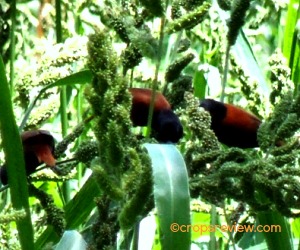Yes, there are grass flowers and all grasses have or possess the ability to produce flowers.
But this conclusion only leads to many questions.
Why don’t we see flowers in these plants? Does Zoysia (also called Bermuda grass) really produce flowers? How about rice and corn? And bamboo?
Well, well, well. These questions are really both easy and excruciatingly difficult.
It largely depends on how botanically prepared is the asker. And more so for the asked and answered.
We should go back to the basics. Let us first answer the questions: What is grass? and What is a flower?
This second question has already been addressed on this site. Click here.

So What Is a Grass? What Are Grasses?
First, grasses are not necessarily weeds and vice versa.
Grasses are plants with reference to taxonomic classification, but weeds are any plants belonging to various classifications, including grasses and non-grass plants, which can have disadvantageous effects on agricultural crops (click on to read What is a Crop and What is a Weed).
Unfortunately, however, the swapping of the terms grass and weed, though erroneous, has already been engraved in the minds of the many young.
For years they have been subjected to “Children, please uproot those grasses,” the word being used as a blanket term for all weeds or nuisance plants regardless of their botanical classification.
Coupled with that “Boy, water our flowers” in referring to ornamental plants including foliage ornamentals, the disinformation becomes deeply rooted.
Now to answer, the grass is any plant that belongs to the family Gramineae(alternatively called Poaceae), also called the grass family.
The family includes such important crops as rice, corn, wheat, and all other cereals, sugarcane, lemongrass, and bamboo.
Consequently, by grass flowers, we are referring to the flowers of the members of Gramineae.
There are many other botanical families of plants such as, to mention a few, Musaceae(banana family), Orchidaceae(orchids), and Palmae or Arecaceae(palms).
A special name is therefore used as a collective term for the inclusive plant species under each family.
All angiosperms produce or have the capacity to produce flowers, all grasses are angiosperms, therefore there are grass flowers
In the taxonomic classification in the kingdom Plantae, Gramineae falls under class Liliopsida (monocots, also called Monocotyledoneae) of phylum Anthophyta or Magnoliophyta, also called Angiospermae or angiosperms.
This preconcludes that grasses have flowers.
This means that authorities in plant taxonomy have already ascertained that all grasses have flowers and so they rightly belong to the angiosperms, also called “true flowering plants”.
To bolster further that there are grass flowers, here’s a portion of the general description of the Gramineae (Grass or Zacate Family) in Flora of Manila by E. D. Merrill (1912):
“Inflorescence various, of few to many spikelets in panicles, racemes, spikes, or heads, the spikelets composed of 2 to many, 2-ranked, imbricated scales (glumes), the lowest ones normally empty, sometimes wanting, one or more of the upper glumes containing a flower enclosed by the bract-like palea. Flowers perfect or staminate, sometimes monoecious or dioecious. Stamens 1 to 6, usually 3. Ovary 1-celled, 1-ovuled. Fruit a seed-like grain (caryopsis).”
So if grass flowers occur in the Gramineae, where are they? Isn’t it that bamboo is a grass species? So why don’t I, nor my friends and relatives, see it flowering?
It’s because the occurrence of flowering depends on many factors.
Any grass plant may not have this floral structure now but at the right time, when the plant is mature enough and the environmental conditions become favorable, it will be there.
As to bamboo, its flowering is a unique phenomenon, one that is still wanting in scientific explanation.
It may take thirty or 60 years, or perhaps over a hundred years for a certain species, but ultimately bamboo will undergo a surprising floral metamorphosis.
It’s quite bizarre, but with favorable conditions mature clumps taken from the same original clump will flower at the same time no matter where they are!
However, the grass flowers are not attractive, showy, nor clearly visible as in those popular ornamentals.
They are in fact tiny and need to be magnified to see the parts in full detail.
They have no perianth (sepal and petal) which is responsible for the attractive color, or it is modified into inconspicuous lodicules.
Each flower is contained in a floret, which consists of an outer lemma and palea, attached to the spikelet several of which comprise the inflorescence.
Depending on the species, grass flowers are either bisexual or unisexual (click on to read more on flower parts).
The tiny, carpet-like Zoysia has flowers.
They are there on those whitish tassels on top of wild sugarcane or talahib (Saccharum spontaneum) and corn.
Rice produces flowers within those spikelets attached to the panicle, otherwise, there will be no grains to harvest.
LITERATURE CITED
MERRILL ED. 1912. A Flora of Manila. Manila: Bureau of Printing. p.71.
